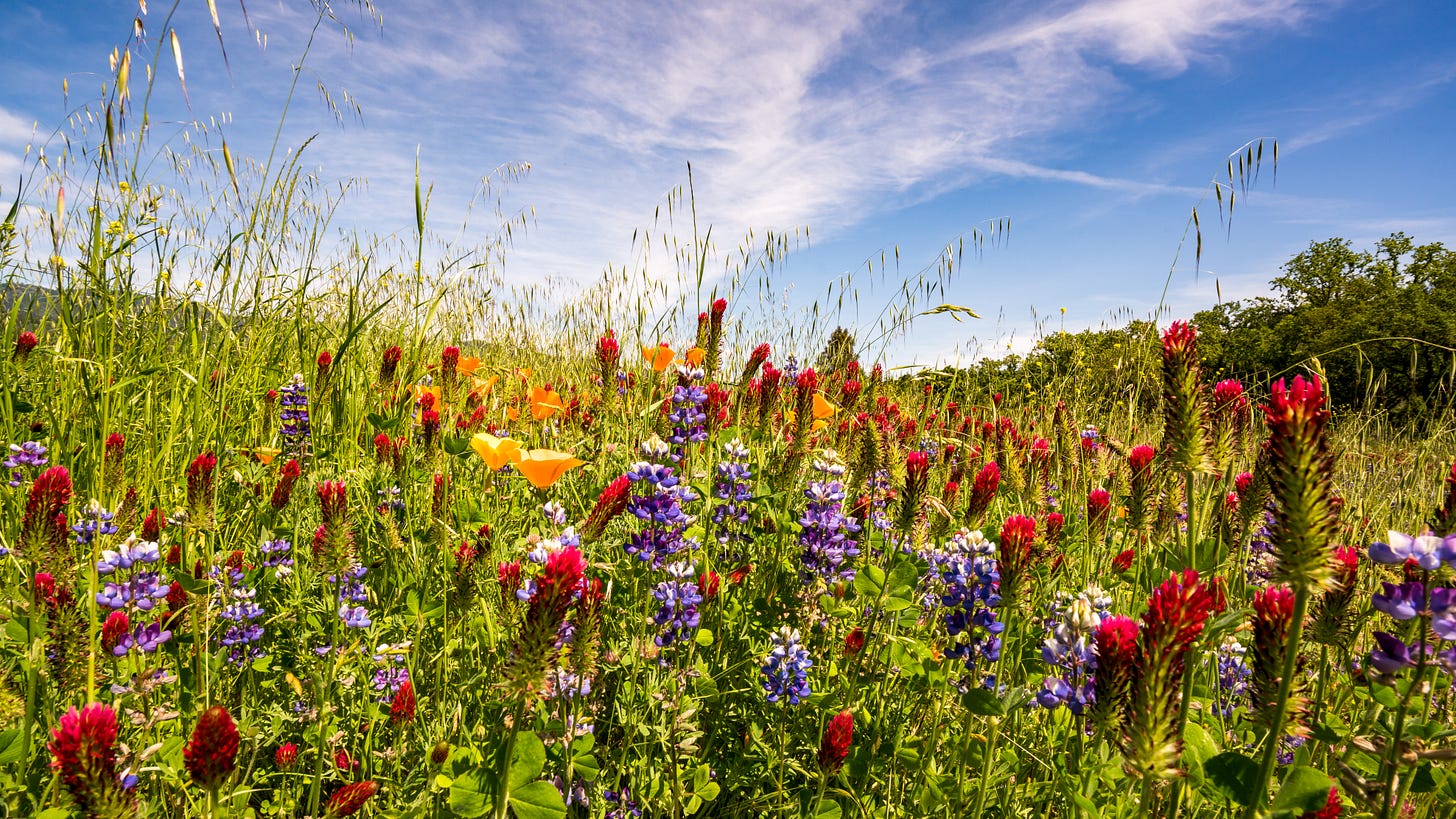Pollinators need the help of local gardeners
By Jane Callier, UC Master Gardener of Napa County
To be good stewards of our precious bees and other pollinators, gardeners should aim to have at least 20 varieties of flowers blooming from early spring through late fall in order to offer a sufficient supply of nectar and pollen. That might may seem like a hefty requirement, but it’s actually easy to achieve, especially if you consider flower-producing trees in the mix.
Think of the abundance of beautiful blossoms on your fruit trees every spring. We know bees cluster around the blooms, sipping nectar and repaying us with the pollen they leave behind. Later we literally harvest the fruits of their labor.
After our wet winter, blooms are bursting on just about everything capable of having a blossom. Flowering dogwoods (Cornus spp.) seem to be everywhere, delighting us with their beauty and providing an abundance of pollen for bees. Mining bees of the Andrena family love dogwood pollen. Dogwood berries have a lot of calcium and fat, providing food for birds, too. Flowering dogwood fills in the calendar from April through June in our annual sequence of food for pollinators.
Western redbud (Cercis occidentalis) is another tree with a striking spring bloom. This California native does well in our dry summers and doesn’t require much water. Among its few drawbacks are that the redbud is slow-growing and its spectacular bloom only lasts a couple of weeks.
The redbud is not a large tree, reaching only 15 feet to 20 feet in height with a similar spread, so having a few of them might be a possibility in a relatively small yard. It wants to be multi-trunked and requires skillful pruning to maintain it in tree form. Hummingbirds, goldfinches, butterflies and bees are attracted to the flowers.
In contrast, consider the northern catalpa. This tree loves water and even tolerates flooding. It is fast-growing, eventually reaching up to 70 feet tall and 50 feet wide. With its massive heart-shaped leaves, it is hard to miss. In bloom the trees are loaded with showy white scented flowers.
Bees pollinate the catalpa flowers during the day, guided by yellow and purple markings inside the blooms. At night the flowers produce more nectar and emit a fragrance that attracts pollinating moths. On the downside, the northern catalpa has a reputation as a messy tree when it drops its spent flowers and long, beanlike seed pods. The catalpa can be grown from seed, producing a functional shade tree in a few years. It may not be ideal for every location, but the northern catalpa is widely grown throughout the country.
Nothing identifies a California landscape like manzanita (Arctostaphylos species). A manzanita has an ideal structural form with its graceful, burnished sorrel bark. Everything about a manzanita says “California native,” including the small gray-green leaves that cling to its branches. The manzanita produces an early supply of late-winter nectar. Its showy clusters of flowers continue through mid-spring. Birds, bees and butterflies love this plant, and once it is well established, it is not bothered by deer.
Manzanitas have glossy green leaves and small white flowers tinged with pink that are followed by small red berries. These trees can be long-lived and become more striking over time if given enough space to grow to their natural size. Over time manzanita will develop an upright mounding form, 6 to 8 feet tall and wide.
Probably because manzanitas are California natives, some don’t thrive in home gardens. The usual grooming, watering and fuss the rest of the garden requires are too much for manzanitas.
Some Arctostaphylos varieties are more garden-tolerant than others, but they dislike wet soil.
Manzanitas need excellent drainage, good circulation, no fertilization and infrequent deep irrigation. Sun or part shade is best. Manzanitas available in nurseries are probably selected for their tolerance of moister conditions. It cannot be stressed enough that too much water will make a manzanita decline before it should. Learn to leave a manzanita alone and let Mother Nature do the watering.
Workshop: Join UC Master Gardeners for a Zoom presentation on “Summer Rose Care” on Saturday, June 10, from 10 a.m. to noon. Participants are invited to attend a hands-on workshop on Wednesday, June 14, from 10 a.m. to noon at Fuller Park in Napa. Learn pruning and irrigation techniques for all rose types and get advice on managing diseases and pests. Space is limited. To get the Zoom link and attend the hands-on workshop, register at Summer Rose Care.
Tree walk: Join UC Master Gardeners for a free guided tree walk on Sunday, June 11, from 10 a.m. to noon at Fuller Park, Oak and Jefferson streets, Napa. You must pre-register to attend; space is limited to 15 people, and each person attending must register separately.
Gardening with the masters: Join UC Master Gardeners on Saturday, June 17, from 10 a.m. to noon at Ole Health Garden, 300 Hartle Court, Napa, for this monthly workshop. Children age 5 and older are welcome with accompanying adult. Class size is limited. Register at Gardening.
Help desk: The Master Gardener Help Desk is available to answer your garden questions on Mondays and Fridays from 10 a.m. until 1 p.m. at the University of California Cooperative Extension Office, 1710 Soscol Ave., Suite 4, Napa, or send your questions to mastergardeners@countyofnapa.org. Include your name, address, phone number and a brief description of the problem. For best results attach a photo of the plant. You may also leave a voicemail message at 707-253-4143.



